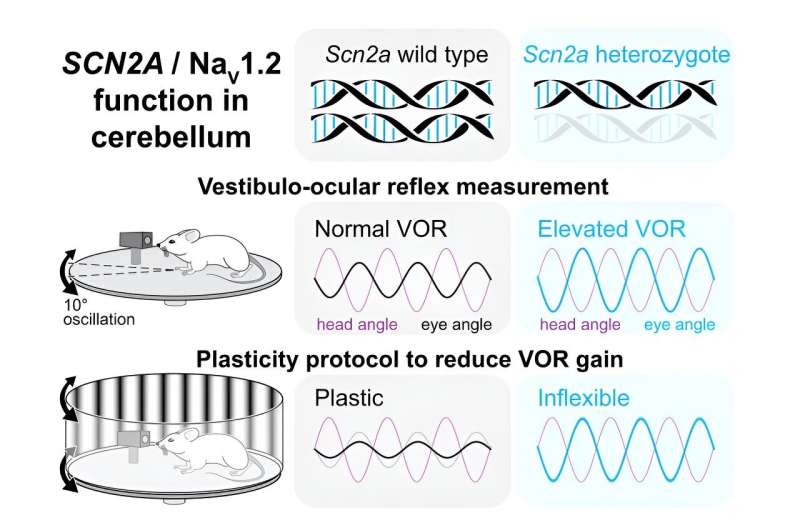This article has been reviewed according to Science X's editorial process and policies. Editors have highlighted the following attributes while ensuring the content's credibility:
fact-checked
trusted source
proofread
A simple eye reflex test may be able to assess autism in children

Scientists at UC San Francisco may have discovered a new way to test for autism by measuring how children's eyes move when they turn their heads. They found that kids who carry a variant of a gene that is associated with severe autism are hypersensitive to this motion.
The gene, SCN2A, makes an ion channel that is found throughout the brain, including the region that coordinates movement, called the cerebellum. Ion channels allow electrical charges in and out of cells and are fundamental to how they function. Several variants of this gene are also associated with severe epilepsy and intellectual disability.
The researchers found that children with these variants have an unusual form of the reflex that stabilizes the gaze while the head is moving, called the vestibulo-ocular reflex (VOR). In children with autism, it seems to go overboard, and this can be measured with a simple eye-tracking device.
The discovery could help to advance research on autism, which affects one out of every 36 children in the United States. And it could help to diagnose kids earlier and faster with a method that only requires them to don a helmet and sit in a chair.
"We can measure it in kids with autism who are non-verbal or can't or don't want to follow instructions," said Kevin Bender, Ph.D., a professor in the UCSF Weill Institute for Neurosciences and co-senior author of the study, which appears Feb. 26 in Neuron. "This could be a game-changer in both the clinic and the lab."
A telltale sign of autism in an eye reflex
Of the hundreds of gene mutations associated with autism, variants of the SCN2A gene are among the most common.
Since autism affects social communication, ion channel experts like Bender had focused on the frontal lobe of the brain, which governs language and social skills in people. But mice with an autism-associated variant of the SCN2A gene did not display marked behavioral differences associated with this brain region.
Chenyu Wang, a UCSF graduate student in Bender's lab and first author of the study, decided to look at what the SCN2A variant was doing in the mouse cerebellum. Guy Bouvier, Ph.D., a cerebellum expert at UCSF and co-senior author of the paper, already had the equipment needed to test behaviors influenced by the cerebellum, like the VOR.
The VOR is easy to provoke. Shake your head and your eyes will stay roughly centered. In mice with the SCN2A variant, however, the researchers discovered that this reflex was unusually sensitive. When these mice were rotated in one direction, their eyes compensated perfectly, rotating in the opposite direction.
But this increased sensitivity came at a cost. Normally, neural circuits in the cerebellum can refine the reflex when needed, for example to enable the eyes to focus on a moving object while the head is also moving. In SCN2A mice, however, these circuits got stuck, making the reflex rigid.
A mouse result translates nearly perfectly to kids with autism
Wang and Bender had uncovered something rare: a behavior that arose from a variant to the SCN2A gene that was easy to measure in mice. But would it work in people?
They decided to test it with an eye-tracking camera mounted on a helmet. It was a "shot in the dark," Wang said, given that the two scientists had never conducted a study in humans.
Bender asked several families from the FamilieSCN2A Foundation, the major family advocacy group for children with SCN2A variants in the US, to participate. Five children with SCN2A autism and eleven of their neurotypical siblings volunteered.
Wang and Bender took turns rotating the children to the left and right in an office chair to the beat of a metronome. The VOR was hypersensitive in the children with autism, but not in their neurotypical siblings.
The scientists could tell which children had autism just by measuring how much their eyes moved in response to their head rotation.
A CRISPR cure in mice
The scientists also wanted to see if they could restore the normal eye reflex in the mice with a CRISPR-based technology that restored SCN2A gene expression in the cerebellum.
When they treated 30-day-old SCN2A mice—equivalent to late adolescence in humans—their VOR became less rigid but was still unusually sensitive to body motion. But when they treated three-day-old SCN2A mice—early childhood in humans—their eye reflexes were completely normal.
"These first results, using this reflex as our proxy for autism, point to an early window for future therapies that get the developing brain back on track," Wang said.
It's too early to say whether such an approach might someday be used to directly treat autism. But the eye reflex test, on its own, could clear the way to more expedient autism diagnosis for kids today, saving families from long diagnostic odysseys.
"If this sort of assessment works in our hands, with kids with profound, nonverbal autism, there really is hope it could be more widely adopted," Bender said.
More information: Chenyu Wang et al, Impaired cerebellar plasticity hypersensitizes sensory reflexes in SCN2A-associated ASD, Neuron (2024). DOI: 10.1016/j.neuron.2024.01.029





















